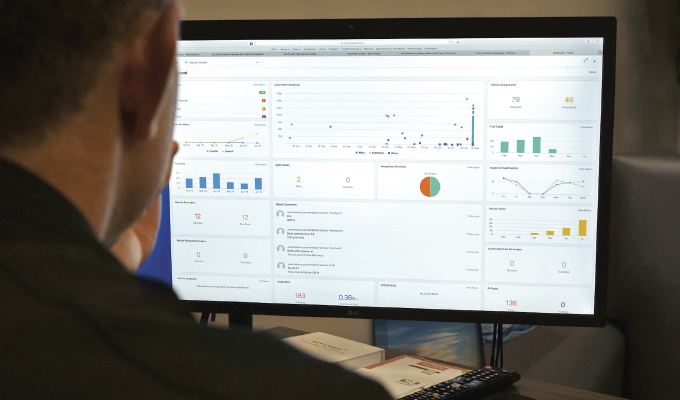When an asset issue arises, making informed decisions quickly can mean avoiding costly setbacks. However, many fleet managers find themselves grappling with disparate data sources — whether from manually documenting data or using multiple disconnected solutions — and struggling to gain a comprehensive understanding of their fleet’s performance.
Implementing a centralized fleet management software (FMS) affords fleets the ability to streamline data collection, aggregation, and analysis, while keeping key metrics front and center on a customizable dashboard.
CHALLENGES OF SILOED DATA
For fleet managers dealing with manual data collection processes and siloed software systems, gaining actionable insights can be quite the undertaking. Manual data entry is time-consuming and error-prone, which can lead to incomplete or inaccurate information, while disparate software solutions often fail to communicate with one another, resulting in fragmented data silos that hinder visibility.
The volume of data available around asset health and overall fleet productivity is vast and can cause difficulties when it comes time to analyze it—especially if you’re having to pull metrics from multiple sources.
Some of the most common obstacles fleets face with data collection and analysis include:
- Lacking necessary data analysis skills: without the ability to interpret it correctly, fleet managers may miss valuable insights buried within their data.
- Delayed access to critical data: waiting for data to be manually entered or transferred between systems can lead to delays in decision-making, hindering operational efficiency.
- Inability to integrate fleet solutions with existing systems: siloed software solutions create barriers to data sharing and collaboration, limiting the ability to access a comprehensive view of fleet health, cost, and productivity.
USING A SINGLE PLATFORM
Centralizing fleet data onto a single platform can help fleets overcome challenges associated with data collection and analysis. FMS automates data collection and consolidation, acting as a kind of hub where aggregate data from various sources—including telematics devices, fuel cards, and maintenance records—come together and interact to provide a holistic view of your operation.
To further help fleets make data-driven decisions, FMS provides:
- Real-time data updates: with real-time access to critical data, fleet managers can respond quickly to issues and make informed decisions on the fly.
- Integration with existing systems: FMS integrates with a wide range of fleet and business solutions, through both integration partnerships and a public application programming interface (API), ensuring a smooth flow of data and reducing bottlenecks in information sharing.
- Customizable dashboards: FMS provides customizable dashboards and data visualization tools that enable fleet managers to interpret complex data sets easily. Arranging your dashboard to keep key metrics front and center makes it easier to quickly and accurately spot trends, patterns, and anomalies.
ANALYZE FLEET METRICS
Since FMS automatically summarizes aggregate data in the background, analysis becomes much easier — and so does avoiding data overload. Data in FMS is displayed in up-to-date fleet reports that express specific metrics from which you can follow an audit trail to source issues.
The cost comparison by year report, for example, aggregates such data as fuel and service expenses, and other costs associated with running each asset over the course of a given year, such as loan/lease, insurance, licensing, and registration payments. FMS uses such costing data and divides it by the difference between an asset’s first and last odometer/meter entries for that year and automatically calculates an asset’s average annual cost per meter.
Fleets can use this report to determine which asset has the highest cost per meter compared to similar assets and what the expected cost per meter is for a given make model year over its useful life.
Additionally, fleets can analyze such data as downtime, recurring issues, and total cost of ownership, to:
- Identify areas for improvement: analyzing downtime and recurring asset issues can help fleets implement better preventive maintenance (PM) schedules, tackle poor driving behaviors, and source the cause of high-fail components.
- Implement proactive maintenance strategies: predictive analytics features like sensor data can help fleet managers anticipate maintenance needs and proactively address potential issues before they escalate.
- Optimize resource allocation and workflow management: fleets can use customization tools in FMS to document downtime related to process inefficiencies, such as understaffing and imbalance workloads in the shop and delays sourcing parts replacements.
When it comes to making operational improvements, fleets can take advantage of FMS to overcome challenges associated with disparate data and make quicker, more informed decisions.
ABOUT THE AUTHOR
Rachael Plant is a content marketing specialist for Fleetio, a fleet management software company that helps organizations track, analyze and improve their fleet operations. To learn more, visit www.fleetio.com.





